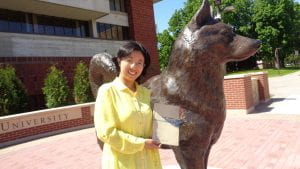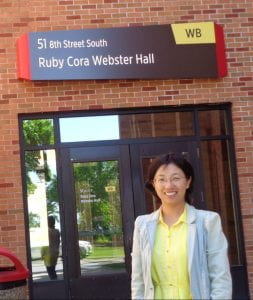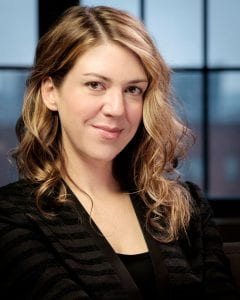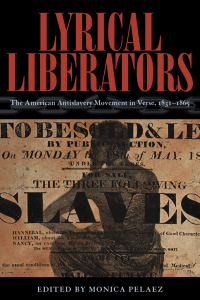Did you know that we recently had a scholar visiting SCSU from China to study Sinclair Lewis? Read more about her time with us here and continue reading to find out more about Sinclair Lewis!
Well, who is he? If you’re from central Minnesota, I’m fairly confident you’ve at least heard of the man. If you’re not from here, you might not know why he is so important to central Minnesotans, especially Sauk Centre residents!
 Sinclair Lewis (full name – Harry Sinclair Lewis) was born February 7, 1885 in Sauk Centre, Minnesota, the most Scandinavian part of America (at that time). His father was a country doctor. Sinclair writes about his childhood, “Until I went East to Yale University I attended the ordinary public school, along with many Madsens, Olesons, Nelsons, Hedins, Larsons. Doubtless it was because of this that I made the hero of my second book, The Trail of the Hawk, a Norwegian, and Gustaf Sondelius, of Arrowsmith, a Swede – and to me, Dr. Sondelius is the favorite among all my characters” (The Nobel Prize).
Sinclair Lewis (full name – Harry Sinclair Lewis) was born February 7, 1885 in Sauk Centre, Minnesota, the most Scandinavian part of America (at that time). His father was a country doctor. Sinclair writes about his childhood, “Until I went East to Yale University I attended the ordinary public school, along with many Madsens, Olesons, Nelsons, Hedins, Larsons. Doubtless it was because of this that I made the hero of my second book, The Trail of the Hawk, a Norwegian, and Gustaf Sondelius, of Arrowsmith, a Swede – and to me, Dr. Sondelius is the favorite among all my characters” (The Nobel Prize).
After public school, Lewis attended Yale University. Lewis claims the only real writing he did during his time at Yale was writing for the Yale Literary Magazine. Interestingly, most of the stories he wrote for this magazine were boring romantic stories. Lewis himself finds his earlier writings interesting when looking at his later writing. He ponders, “Whether imaginary castles at nineteen lead always to the sidewalks of Main Street at thirty-five, and whether the process might be reversed, and whether either of them is desirable, I leave to psychologists” (The Nobel Prize).
 After graduating from Yale in 1907, Lewis worked as a reporter and editor. Later, he wrote for popular magazines such as The Saturday Evening Post and Cosmopolitan but always wanted to be a serious novelist. In 1914, he published his first novel, Our Mr. Wrenn which received favorable criticism but few readers. In 1920, Lewis’ literary reputation was established with the publication of Main Street. It is told from the perspective of Carol Kennicott, an Eastern girl married to a Midwestern doctor who settles in the fictional town of Gopher Prairie, Minnesota. Gopher Prairie is inspired and modeled after Lewis’ hometown of Sauk Centre.
After graduating from Yale in 1907, Lewis worked as a reporter and editor. Later, he wrote for popular magazines such as The Saturday Evening Post and Cosmopolitan but always wanted to be a serious novelist. In 1914, he published his first novel, Our Mr. Wrenn which received favorable criticism but few readers. In 1920, Lewis’ literary reputation was established with the publication of Main Street. It is told from the perspective of Carol Kennicott, an Eastern girl married to a Midwestern doctor who settles in the fictional town of Gopher Prairie, Minnesota. Gopher Prairie is inspired and modeled after Lewis’ hometown of Sauk Centre.
Much of the success of this novel came from Lewis’ accurate use of local speech, customs and social amenities. According to Britannica.com, “The satire is double-edged—directed against both the townspeople and the superficial intellectualism that despises them. In the years following its publication, Main Street became not just a novel but the textbook on American provincialism” (The Editors of Encyclopaedia Britannica).
After Main Street, Lewis led a busy life. He married Dorothy Thompson in 1928 in England, travelled a lot, but claims his travels were quite boring, and in 1930, became the first American to win the Nobel Prize in Literature. He died in Rome, Italy on January 10, 1951, just a month shy of his 66th birthday. If you would like to read more about Sinclair Lewis, check out his autobiographical narrative written for his winning of the Nobel Prize here, or click here to read a comprehensive biography written by the Encyclopaedia Britannica.
If Sinclair Lewis is interesting to you and you’re in the area, we at the English department would like to encourage you to check out Sauk Centre and all things Sinclair Lewis there.
Here are some of our favorite Sinclair Lewis sites!
 The Sinclair Lewis Boyhood Home – Lewis lived here from 1889 until 1902. You can take a tour of the home. The entire home has been restored to include antiques appropriate to the time period! For more information, click here!
The Sinclair Lewis Boyhood Home – Lewis lived here from 1889 until 1902. You can take a tour of the home. The entire home has been restored to include antiques appropriate to the time period! For more information, click here!- Gopher Prairie Inn – If you’re spending the night, check out the Gopher Prairie Inn! Now, even though I couldn’t find confirmation of this fact, but it seems logical to claim that the Gopher Prairie Inn was named after the Gopher Prairie town in Lewis’ Main Street. Either way, if you want to book a night, click here!
 Sinclair Lewis Avenue – If you’re looking for a nice drive through town, this is the avenue for you to take!
Sinclair Lewis Avenue – If you’re looking for a nice drive through town, this is the avenue for you to take!- Main Street – It’s hard to visit Sauk Centre without driving Main Street. Taking a trip down Main Street will make you feel like you’re driving through the past! See how many references to Sinclair Lewis you can find!
If you’re looking for other things to do in and around Sauk Centre, we recommend:
- Walking/Hiking/Biking on the Wobegon Trail
- Shopping along Main Street
- Viewing at movie at the Main Street Theatre
- Tasting some cheese at the Redhead Creamery
- Driving around Sauk Centre and admiring all the beautiful murals
- Grabbing a bite to eat at the Ding Dong Café
Let us know if you’ve ever been to Sauk Centre and what you love to do in the small town!
Works Cited:
The Editors of Encyclopaedia Britannica. Sinclair Lewis. 3 Feb. 2020, www.britannica.com/biography/Sinclair-Lewis.
The Nobel Prize. The Nobel Prize in Literature 1930. 2020, www.nobelprize.org/prizes/literature/1930/lewis/biographical/.




